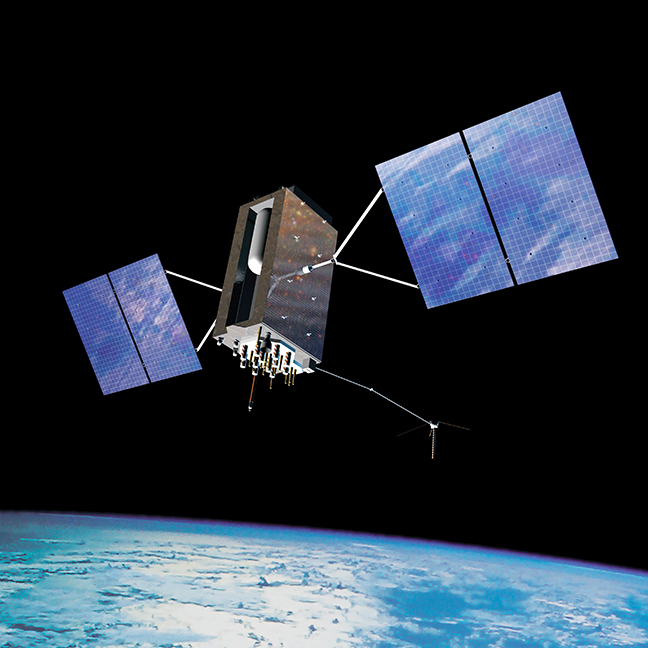The Air Force says it might ask Congress for permission to implement bigger buys of GPS satellites beginning in fiscal year 2016 (FY16) once it sorts out whether to drop Lockheed Martin as the GPS III prime contractor and switch to a different manufacturer for the navigation payload.
The department told Congress in a recent report on multiyear procurement (MYP) that while its current approach “allows the government the flexibility to adapt to a changing budget profile and constellation needs, it prevents the program from realizing savings that MYP could provide.”
The Air Force says it might ask Congress for permission to implement bigger buys of GPS satellites beginning in fiscal year 2016 (FY16) once it sorts out whether to drop Lockheed Martin as the GPS III prime contractor and switch to a different manufacturer for the navigation payload.
The department told Congress in a recent report on multiyear procurement (MYP) that while its current approach “allows the government the flexibility to adapt to a changing budget profile and constellation needs, it prevents the program from realizing savings that MYP could provide.”
The Air Force said it is currently buying an average of two satellites per year under an annual buy structure. Defense officials wrote, however, that they were conducting “trade-off analyses” associated with future GPS spacecraft acquisition strategies — evaluating the evolution of future GPS III requirements, GPS constellation sustainment need dates, and GPS program affordability within the defense budget.
They plan to present a new GPS acquisition approach to the Pentagon if they determine that the plan is affordable under current budget constraints. That approach would need to balance cost, performance, and flexibility, they said.
“If DoD decides to pursue an MYP for GPS III, the associated FY16 President’s Budget request will reflect a funding profile to support this,” officials wrote in the report.
Although only released this month, the report was sent to Congress in April — well before the June release of the GPS III sources sought solicitation. With that solicitation the Air Force initiated an effort to determine if other firms would be capable of managing the GPS III program and building the satellite’s navigation payload. The GPS III program has been delayed significantly because of interference problems in the current navigation payload, angering program managers.
It soon became clear, however, that the solicitation might be about more than changing contractors. Inside GNSS learned that defense officials may want to use the opportunity to switch to an all-digital navigation payload. The technology, which only now is becoming technically feasible, offers cost advantages as well as the ability to add signals without launching new satellites.
With so much in flux it is easy to understand why the Air Force told Congress a multiyear buying strategy was not feasible for GPS III until at least FY16 — even though the program would meet all of the criteria for MYP now.
Once things are sorted out, however, there are a lot of reasons to shift to a MYP.
“Larger buys ensure a common configuration, mitigate schedule risk, and mitigate diminishing manufacturing sources and material shortage,” the report said. “This also helps to eliminate the potential risk for part redesign and delta qualification tests.”
Some increased costs exist with MYP, however, such as storage expenses for warehousing the satellites until they are needed. Nonetheless, multiyear buys could also cut the time and money spent doing testing to ensure that each batch of material and parts meets specifications.
“This testing, and the sample parts required to support (the testing), add cost each time a lot is purchased,” Congress was told. “GPS III utilizes more than 13,500 electrical, electro-magnetic, electro-mechanical and electro-optical (EEEE) parts. These fixed costs for parts and material can be reduced through larger quantity procurements, which necessitate fewer lot buys.”
Whatever the advantages, Congress may not be prepared to change its tactics on budgeting.
“Multi-year procurement is much like multi-year appropriations,” said federal budget expert Stan Collender, the national director of financial communications for Qorvis Communications. “It’s talked about all the time because in theory it seems like a good idea. The likelihood, however, of Congress going along with multiyear procurements, as opposed to annual decisions, is so small that it makes it almost laughable to talk about. You’re asking Congress to give up a good deal of control, which is the last thing that it wants to do.”
A list of programs using multiyear procurement in a July 30 report on the practice by the Congressional Research Service reveals no recent satellite programs — in fact, no MYP satellite programs have taken place at all since GPS and Defense Support Program satellites were ordered in 1991.
Although Congress would seem to be interested in MYPs because they were the ones that asked for the report, that does not actually mean they want to make changes.
“Asking for a report is often the easiest way of avoiding the subject,” Collender told Inside GNSS. “That doesn’t necessarily mean that Congress is interested in the topic or has a preference that it should be done in a certain way. In fact usually reports are the best way of tabling a topic without actually making it look like you said ‘No’.”





